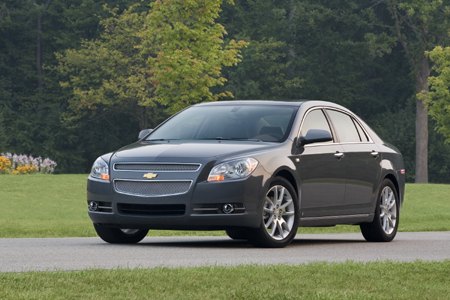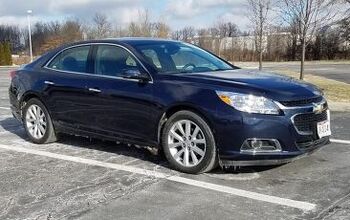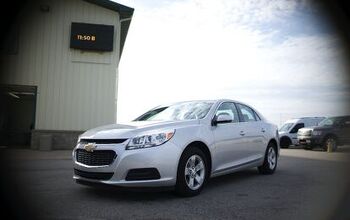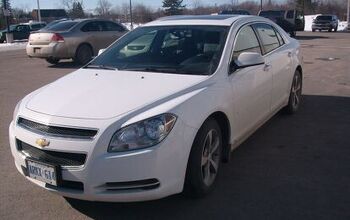Chevrolet Malibu Review
We’ve all heard GM’s party line too many times: “Sure, we’re not doing so well with our current products. But we’ve redesigned the [insert model name]. It’s going to bring new car buyers flooding back to [insert brand name].” Each time, the new product has fallen short. Each time, GM has surrendered market share, especially in the midsize sedan segment it once dominated. Does the latest object of GM’s hype, the redesigned 2008 Chevrolet Malibu, continue this downwards trend?
Let’s face it: only die-hard loyalists listen to/believe anything GM says these days. So the only way a new GM product is going to get noticed outside the fold is if it looks 1) like nothing else and 2) damn good. Despite sharing sub-skin bits with the Pontiac G6 and Saturn Aura and cribbing from the Acura TL, the new Malibu actually delivers on both counts. People who haven’t considered a Chevrolet in eons may become interested after seeing the car.
As a Chevrolet, the Malibu is theoretically at the bottom of GM’s totem pole. For once, GM isn’t aesthetically hobbling a Chevrolet to make room for other divisions’ models. The Malibu’s artfully curved bodysides, formal C-pillar and Lexus-like brightwork provide a more upscale appearance than the equivalent Pontiac or Saturn. The prow might prove controversial, but it makes a strong, distinctive statement without the use of a gaping grille or sci-fi aesthetics. Trim alignment could be better, though.
Inside, we’ve got two tones, retro curves and cut lines galore— the sort of multivarious approach GM’s interior designers have long favored. In the past, after the bean counters and manufacturing engineers had their wicked way, the result has been a tacky mess. This time GM stayed true to the concept.
The Malibu cabin’s lines flow the way the original designers intended, the workmanship is first-rate and the materials vie for best in segment. Sure, the door pulls and some close-at-hand panels are hard plastic, but so are the same bits in the competition. There’s more of the soft-touch stuff than you’ll find in an Accord or Camry.
The Malibu’s driving position falls close to class average– not too low or too high. Legroom is plentiful in both the front and rear seats. The moderately firm seats provide proper support. And au courant ambient lighting is a welcome and unexpected standard feature in this class.
If there’s one place the interior falls down, it’s shoulder room. Time was American cars were much beamier than their competitors. But the Epsilon platform that underpins the new Malibu was developed with European markets in mind, so you’ll actually find a couple inches more shoulder room in a Toyota Camry or in the newly supersized Honda Accord. A relatively tight cabin lends the Malibu a sportier feel, but isn’t good if you want to scrunch three adults into the back seat.
So the new Malibu’s exterior and interior styling could bring people back into a Chevrolet showroom for the first time in decades. The test drive could still disappoint.
Chevy offers two engines: a 169-horse four and a 252-horse V6. The four, like those in competing sedans, provides merely adequate acceleration. The V6 is literally overwhelming. Mash the go-pedal at low speeds and the steering wheel jiggles this way and that as the Eagle LSs fight for traction. Either transmission shifts smoothly, but the V6’s paddle shifters are about as useful as mammaries on a mule. The six-speed slushbox doesn’t react promptly to manual inputs, preferring a prod from your right foot.
Toss the new Malibu through some turns and you’ll find excellent composure and well-checked body lean– but not the sharpness of a hardcore sport sedan. The base 16-inch tires look dinky and provide little grip; the V6’s 18-inch treads hang on considerably better, and mutter quietly as their limits are approached.
Weighting feels more natural with the V6’s hydraulic steering than with the electric rack in the four, but neither system provides much feedback. The feel through the wheel is solid and steady rather than quick and sharp. Enthusiasts should opt for the LT2, where faux suede center panels usefully augment the seat’s side bolsters.
The Malibu’s chassis excels in one key area: providing a smooth, quiet ride. Even over nasty stretches of pavement you’d better keep an eye on the speedometer to avoid flashing lights in the rearview. For the typical midsize car buyer, the ride-handling balance is outstanding. The Bu serves-up less wallow than the vanilla Camry, and it’s smoother than the Accord or Camry SE.
The bottom line: the new Chevrolet Malibu backs up its upscale looks with an upscale feel. Potential customers [theoretically] drawn to Chevrolet showrooms by the Malibu’s sheetmetal won’t be disappointed by the rest of the car. GM has finally built it. But will they come?
[Michael Karesh invites Malibu buyers to join TrueDelta's reliability panel.]
Michael Karesh lives in West Bloomfield, Michigan, with his wife and three children. In 2003 he received a Ph.D. from the University of Chicago. While in Chicago he worked at the National Opinion Research Center, a leader in the field of survey research. For his doctoral thesis, he spent a year-and-a-half inside an automaker studying how and how well it understood consumers when developing new products. While pursuing the degree he taught consumer behavior and product development at Oakland University. Since 1999, he has contributed auto reviews to Epinions, where he is currently one of two people in charge of the autos section. Since earning the degree he has continued to care for his children (school, gymnastics, tae-kwan-do...) and write reviews for Epinions and, more recently, The Truth About Cars while developing TrueDelta, a vehicle reliability and price comparison site.
More by Michael Karesh
Latest Car Reviews
Read moreLatest Product Reviews
Read moreRecent Comments
- AMcA My theory is that that when the Big 3 gave away the store to the UAW in the last contract, there was a side deal in which the UAW promised to go after the non-organized transplant plants. Even the UAW understands that if the wage differential gets too high it's gonna kill the golden goose.
- MKizzy Why else does range matter? Because in the EV advocate's dream scenario of a post-ICE future, the average multi-car household will find itself with more EVs in their garages and driveways than places to plug them in or the capacity to charge then all at once without significant electrical upgrades. Unless each vehicle has enough range to allow for multiple days without plugging in, fighting over charging access in multi-EV households will be right up there with finances for causes of domestic strife.
- 28-Cars-Later WSJ blurb in Think or Swim:Workers at Volkswagen's Tennessee factory voted to join the United Auto Workers, marking a historic win for the 89- year-old union that is seeking to expand where it has struggled before, with foreign-owned factories in the South.The vote is a breakthrough for the UAW, whose membership has shrunk by about three-quarters since the 1970s, to less than 400,000 workers last year.UAW leaders have hitched their growth ambitions to organizing nonunion auto factories, many of which are in southern states where the Detroit-based labor group has failed several times and antiunion sentiment abounds."People are ready for change," said Kelcey Smith, 48, who has worked in the VW plant's paint shop for about a year, after leaving his job at an Amazon.com warehouse in town. "We look forward to making history and bringing change throughout the entire South." ...Start the clock on a Chattanooga shutdown.
- 1995 SC Didn't Chrysler actually offer something with a rearward facing seat and a desk with a typewriter back in the 60s?
- The Oracle Happy Trails Tadge






































Comments
Join the conversation
[...] best sedan GM has built on a long time. Nice interior cabin, imho. Here's an interesting review: http://www.thetruthaboutcars.com/che...malibu-review/ [...]
I'm late to the party. I just spent a week driving a rental Malibu and was very impressed, which is saying something because I've always been a Japanese-cars-only guy (barring a soft spot for jeeps). The Malibu was a calm freeway cruiser with a comfortable ride that was neither too stiff nor too floaty. The inline four had plenty of torque off the line, and was quiet and smooth. I loved the interior- supportive seats with excellent range of adjustment, and all the controls were intuitively placed and operated nicely. I really enjoyed driving the car. Two complaints- the parking brake pedal seemed to be placed a little too high, and the A pillars obstructed visibility a bit. The Malibu felt quieter on the highway than an Accord and just seems nicer overall than a Camry. Despite my general disdain for GM, I'd seriously consider one if I were in the market for a sedan.